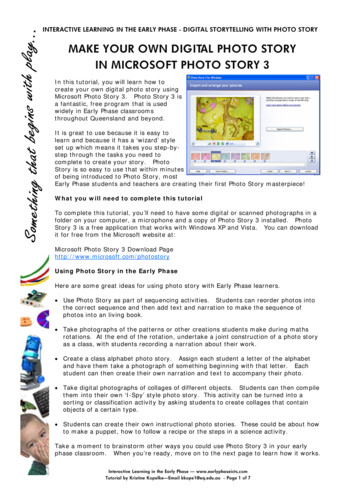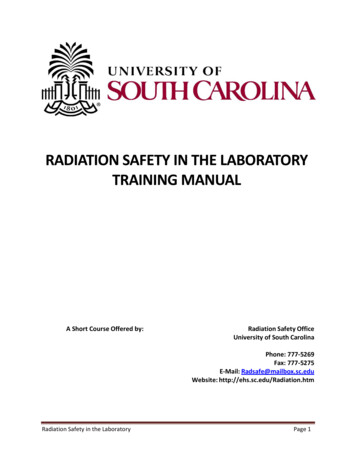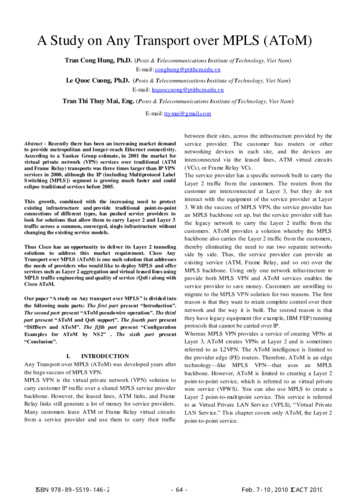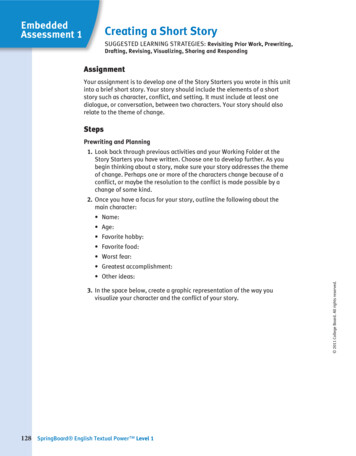
Transcription
The Storyof the Atom(aimed at middle-schoolers,fascinating for adults)By Joy HakimThe One Basic ThingA long, long time ago, actually it was about 2,500 yearsago—which was before Socrates, or Plato, or Aristotle, orany of the Greeks you may have heard about—there lived aman named Thales (THAY leez). He is said to be the world’sfirst philosopher-scientist. The first to look for explanationsin observed facts, not myths. The first scientist to leave hisname on his ideas.We don’t know much about Thales as a person, exceptwhat others tell us. And they tell of a many-sided geniuswho was a lawgiver, a civil engineer (he changed the direction of the Halys river), an astronomer, a mathematician,and a teacher. It is said that he predicted the solar eclipse ofMay 28, 585 B.C., and that he figured the height of a pyramid by measuring its shadow, using the Sun’s position to doit. Perhaps most important to people of his time, he workedout a way to tell distance at sea. For seafaring people, thatwas an enormous achievement.Thales tried to discover a basic unit, or element of life.After many years as a teacher, reporter, and editor, Joy Hakimnow writes nonfiction stories for children. She is completing a6-volume history of science for middle-schoolers, from which thisarticle is drawn. Her 10-volume set, A History of US, whichAmerican Educator introduced with articles in 1990 and 1993,earned the Michener Prize In Writing and is now being adaptedfor a PBS series called “Freedom” that will air early next year.The science books should be published by fall 2003; as publication information becomes available, it will be posted on our Website (www.aft.org/publications/american educator). Forother information and how to become a test site, contactbyron@amerhistpub.com. Special thanks to physicists JohnHubisz, president of the American Association of Physics Teachers; Hans Christian von Baeyer, professor at the College ofWilliam and Mary; and Gerald Wheeler, executive director of theNational Science Teachers Association, for their assistance.12 AMERICAN EDUCATORWater—which takes three forms (solid, liquid, gas)—seemed logical. It was a reasonable start for a search thatcontinues today.The world is full of differences, and yet, Thales had theidea that underneath all the complexity there is a plan—some call it a divine plan—that explains everything. He, andhis followers in Greek-speaking Ionia (today, westernTurkey), looked for answers in the world about them, not inmythology or wizardry.Thales asked, “What is the nature of matter?” By that hemeant: What are we made of? What is the world made of? Isthere one thing that ties everything together?Those questions are the big ones that scientists from histime until now have tried to answer. Is there something thatis basic to all life? Keep reading and see if you can find theanswer to that question.“Earth, Air, Fire, and Water,” says EmpedoclesThales said life’s basic element is water. Another Ionian,Anaximedes, said it was air. Other Greeks said fire, or earth.Empedocles (em PED uh kleez), who lived in the fifth century B.C., said it was all four of those: earth, air, fire, andwater.That idea of four elements—earth, air, fire and water—was one of the longest lasting and most influential scientifichypotheses in all of world history. For centuries and centuries and centuries (more than 2,000 years) people believedit—although it would turn out to be wrong. Some childrenwere still being taught about earth, air, fire, and water in19th-century American schools.Empedocles was wrong in the elements he chose, butright in his idea that, instead of a world where everything isdifferent and unrelated, there are certain basic substancesthat combine to make up everything else. We now realizethat earth, air, fire, and water aren’t basic elements. We’vefound over 100 elements (we discovered some of them inhigh-technology lab experiments). It was the Ionians whogot us searching in the right direction.What’s important to remember about all this is that theSPRING 2002ILLUSTRATED BY NENAD JAKESEVIC/PHOTOGRAPHS BY BETTMANN/CORBIS AND GETTY IMAGESI. The Ancients
The Ionians had come up with thosefour basic elements. Democritusthought there must be somethingstill smaller, something they all hadin common.Greeks trusted their brains, and they understood that toknow the large (the universe), they must investigate thesmall (basic elements). That’s exactly what science doestoday.“Numbers,” says PythagorasPythagoras (puh THA guh russ) was born (in 582 B.C.) ona Greek island, Samos, which had a world-class prosperousport. When Pythagoras was a boy, ships carrying new ideasseemed to blow in on almost every breeze. Samos boastedengineering marvels: a tunnel with water pipes cut through abig hill, a manmade harbor, and the largest of all knownGreek temples. But its greatest marvel would turn out to bePythagoras himself. He tied philosophy to mathematics.How do you make sense of the universe? Is it a messyplace that takes on meaning as we slog through mountainsof information—trying this, trying that—adding one blockof knowledge to another? (Believe that and you’re an Ionianstyle scientist.)Or, is it an orderly, perfect creation that can be understood through mathematical formulas and headwork? (Believe that and you’re a Pythagorean.)Actually, the modern scientific method combines bothapproaches—pure thinking along with observation and attempts to find proofs (through experimentation)—but ittook a long time to get that method working.For Pythagoras, the way to understand the universe wasby searching for things that are absolutely true—and numbers seemed perfect for that quest. “All is number,” he said.And he meant it. Everything in the world, he believed,could be explained through mathematics. He went still further; he believed numbers were divine, an expression ofGod’s mind.By plucking musical strings of different but carefully measured lengths with the same tension, he found that soundshave exact number relationships. That gave order to musicthat no one had imagined before. If music can be explainedmathematically, why not other things?He focused on the horizon; then he cut through that horizontal plane with a straight up and down vertical line andhe had a right angle. Pythagoras must have played with rightangles in his mind. He is identified with a theorem thatseems simple to us now, but was an astonishing achievement: The square of the hypotenuse (the longest side) of a righttriangle equals the sum of the squares of the other two sides. It’s14 AMERICAN EDUCATORcalled the Pythagorean Theorem: A2 B2 C2.Some historians say the Babylonians knew that theorembefore Pythagoras, but he understood its importance and introduced it to the Greek-speaking world. Whatever the historical truth, he usually gets the credit.There is an exactness to the world, an orderliness, and itfollows rules that can be proved with numbers—that’s whatPythagoras told us, and it has been confirmed again andagain.Pythagoras believed that the universe has a mathematicalbase, and that its structure and relationships can be described with mathematical formulas. He made that a foundation of Western science. No one has done more.“There’s an ‘atom,’” says DemocritusI would rather understand one cause than be King of Persia,said Democritus (duh MOK rih tus), who was born about ahundred years after Pythagoras. Now the King of Persia hadabout as much power as anyone could have—and he wasfabulously wealthy, too—so only those who understood thepower of ideas would get what Democritus was saying.Democritus was born in Thrace, which was an unfashionable, out-of-the-way place for a philosopher. “What can youexpect from someone born in Thrace?” people may havesaid. It was a country to the west of the Black Sea and northof the Aegean, and it was not a center of philosophy. Butthat never stopped powerful thinker Democritus.Democritus believed that to understand the universe youneed to know what it is made of. The Ionians had come upwith those four basic elements: earth, air, fire, and water.Democritus thought there must be something still smaller,something that unified these “elements”—something theyall had in common.He said there had to be a smallest substance in the universe that can’t be cut up or destroyed and is basic to everything else. He called that smallest substance an “atom” (fromA-tomos, which means “unable to be cut”). “Nothing exists,”said Democritus, but “atoms and the void.” (By void, hemeant empty space—nothingness.) The atoms that Democritus had in his mind were solid, hard, and compact.Nothing could penetrate them. They were in constant motion, and they were too small to be seen.Much of what we know of Democritus is hearsay. Exceptfor a few words, his writings have been lost. (In those daysbefore printing, all books had to be hand-copied so thereweren’t many copies.)Was he right? Is there a basic building block of life? Asmallest of the small out of which comes everything? It’s aquestion we’re still considering.But brains and imagination can only take you so far inscience, and then you hit a wall. Without the technology toexperiment and test things, you can’t confirm your ideas.That was the problem the Greeks faced. There didn’t seemto be any place to go with science. It was hopeless to lookfor atoms; if they existed, they were too small to be seen.So the next generations headed in a different direction.Socrates (SOCK ra teez—465? to 399 B.C.), who lived inAthens and was called the wisest man in the world by theSPRING 2002
Oracle of Delphi, turned from physical science to a study ofthe human soul. “Know thyself,” he told his followers, echoing the words of that oracle. This is good advice but itdoesn’t do much for scientific research.Socrates never got interested in atoms. Neither did his famous student, Plato, or Plato’s famous student, Aristotle.Aristotle was an organizer and a classifier and an all-aroundthinker with a mind few others have matched. But he rejected the idea of atoms. He thought that even those basicsubstances, called “elements,” could be divided endlessly—and that you’d never get anything else. There is no bottomline particle, said Aristotle. Forget atoms, he said. And, forcenturies to come, most scientific thinkers did just whatAristotle told them to do.II. The ‘Atom’ Idea ReturnsWhy Can You Compress AirWithout Changing Its Weight?But there was something about those tiny particles—theykept popping up in inquisitive minds. One belonged toThomas Harriot, an Englishman who went to the NewWorld with Sir Walter Raleigh and wrote a popular bookabout what he saw there. Later, in a letter to fellow scientistJohann Kepler, Harriot suggested that Kepler “abstract andcontract yourself into an atom” and enter “nature’s house .And when you come out again, tell me what wonders yousaw.”Robert Boyle (1627-1691), who was born in a castle afew years after Harriot died, was a prodigy (a young genius).In addition to being very smart, he was rich and lucky andhad loving parents who took him on trips through Europe.When he was 14, he got to meet Galileo, the greatest scientist of that time—and one of the greatest scientists ever.(He’d already read all of Galileo’s writings.) Galileo told himto study science. He took that advice.Boyle was fascinated with air; then no one knew it wasmade of several gases because no one had ever analyzed air—or any gas. In 1657, Boyle got his assistant, Robert Hooke,to design an air pump; with it, they were able to create avacuum in a tube.In 1663, Robert Boyle did a famous experiment with thepump, showing that if you take air in a large container andsqueeze it into a smaller space, it will be smaller in volumebut not in weight.Later, he came up with what is known as Boyle’s Law:The volume of a gas is inversely proportional to the pressure puton it (as long as its temperature stays the same). In otherwords, if you want to squeeze a volume of gas into half itsspace, you need to double the pressure put on it and viceversa. Boyle’s Law, which really is quite simple, is a very important scientific milestone, although few took it seriously atthe time. According to Samuel Pepys (PEEPS), who wroteabout it in his diary, England’s King Charles II “mightilylaughed” when he heard the scientists at the Royal Societywere “spending time only in weighing of air, and doingnothing else since they sat.”SPRING 2002Boyle found that air could be squeezed into a smaller spacewithout changing its weight.From his experiments with air, Boyle figured out that thevolume of a gas depends on the amount of pressure on it—doubling the amount of pressure cuts volume in half.Boyle then realized that air must be made of tiny particlesand empty space— future scientists understood that thoseparticles were atoms.But some earnest scientists understood the importanceof Boyle’s Law. (It is still the starting point for much scientific research with gases, so it is worth rereading.)Boyle’s Law got scientific thinkers asking, “What can airbe made of if you can change its size and shape withoutchanging its weight?” Boyle said gases must be composed oftiny “corpuscles” (KOR puss ulz, little particles) and a lot ofempty space, which is the reason a fixed amount of a gas canbe squeezed from a big container to a small container. Withhis corpuscle idea, he was going back to the Greek theory ofatoms. Isaac Newton, who was 15 years younger than Boyle(and, like Galileo, one of the greatest of all scientists), alsobelieved in atoms. But he was so busy inventing calculus,finding the laws of motion, tracking down gravity, andstudying light that he didn’t have much time to work on theatomic idea. (It was Robert Boyle who financed Newton’sgreat book on science, The Principia.) Though he didn’tclosely study atoms, Newton had a picture of those tiny parAMERICAN FEDERATION OF TEACHERS 15
Test Boyle’s IdeasTry to compress a liquidFill a balloon with a little water and tie the end. Try tosqueeze it between twoplastic beakers. You cannotsquash the water into asmaller space.Liquids cannot besquashed, so when youpush on one part of aliquid, pressure is carried toall other parts of it.Try to compress a gasBlow a little air into a balloon and tie up the end. Try tosqueeze it between two beakers. Unlike water, you cansquash the air into a slightly smaller space.Gases can be squashed, or compressed, into a smallerspace. A compressed gas, like air in a balloon, pushesout equally in all directions. The more you compress agas, the higher the pressure inside it.Based on the 1997 edition of Annabel Craig and Cliff Rosney’sThe Usborne Science Encyclopedia (Usborne Publishing Ltd.).ticles in his head. He said, “It seems probable to me thatGod in the beginning formed matter in solid, massy, hard,impenetrable, movable particles.” (Keep reading to see if hewas right.)Not many people paid attention to any of this. Theredidn’t seem to be a chance of actually seeing atoms. But, inSwitzerland, a young mathematician named DanielBernoulli read Boyle and the Greeks and took those tinycorpuscles seriously.What Creates Pressure in a Gas?Daniel Bernoulli (burr NEW lee) wanted to be the Newtonof the 18th century; he thought he could do it by studyingfluids (by that he meant liquids and gases).Daniel, who was born in 1700, had the background to gofor it. His father, Johann, and his uncle, Jacob, were bothworld-famous mathematicians and they both hated IsaacNewton (who was now dominating the world of science).Daniel was another prodigy: he could deal with numbers atan amazingly early age. But his career wasn’t as easy for himas you might think; his father, Johann, was not your normalloving dad—he was jealous, nasty, and miserable.Johann decided that his son would become a merchantand enter the family pharmacy business. But Daniel wantedto study mathematics. He was good at mathematics, and hewas a terrible businessman. He failed as a pharmacist. Johann then insisted that his son Daniel go to medical school,but he did allow him to study mathematics on the side. Johann also answered his son’s questions, and, since Johann16 AMERICAN EDUCATORwas one of the best mathematicians in the world, Daniel gotvery good training.One of the things that preoccupied the great professor Johann Bernoulli was a little-studied phenomenon called visviva (“living force”) in Latin. It was what we call energy, andno one understood it. Daniel was fascinated—vis viva wasinvisible, but clearly powerful.When Daniel finished medical school—with topgrades—he expected to get a professor’s job in Basel, and hewanted it to be in mathematics. He got no help from his father and ended up in Russia at the influential Academy ofScience. His experiments and writings soon made himwidely known. He began winning prestigious scientificprizes. He didn’t know it, but his father was fuming.In 1735, both Daniel and his father wrote papers for theParis Academy of Sciences, which gave a big prize that wasmuch like today’s Nobel Prize. That year, the top prize wassplit; it was awarded to the two Bernoullis—father and son.Daniel came home to Basel. He thought his father would bepleased, but Johann was furious. He decided his son was tryingto take over his position as Europe’s top mathematician. Johannthrew his son out of the house, and Daniel never returned.Now, all of that is like gossip, interesting but not reallyimportant. What Daniel accomplished though, became alandmark in science. As with so many achievements, itsounds simple, but no one else had figured it out.Bernoulli considered motion and came up with a veryuseful principle. Strange as it may seem, when the speed of afluid increases, its internal pressure decreases proportionately. Or: As the pressure in a fluid goes down its speed goes up.If that simple theorem (idea) doesn’t interest you, don’tconsider a career in engineering. You can’t design airplanesor ships or even bridges if you don’t understand Bernoulli’sprinciple. If you want to build a carburetor or an atomizer,where air is the moving fluid, you’ll use Bernoulli’s principle.In an aspirator, water (or another liquid) does whatBernoulli said it should do.The principle, in simple language, is this: The faster afluid (liquid or gas) is traveling over a surface, the lower itspressure. Engineers designing airplane wings know (thanksto Bernoulli) that the air flowing over the upper surface ofan aircraft wing must move faster than air flowing beneaththe wing. When that happens, the pressure will be lower ontop of the wing, higher below the wing, and that will helpthe airplane lift.That principle of Bernoulli’s also led to a “conservation”law that says the total energy in a fluid stays the same nomatter what shape the fluid takes. If a liquid or gas goesfrom a big bottle into a smaller container, the speed of itsatoms and the pressure of those atoms against the containerwill change but its total energy will not.Daniel Bernoulli went even further than Robert Boyle inanticipating atoms. Bernoulli seems to have pictured themin his mind; he said it is the random, constant motion ofatoms hitting the walls of a container that explains pressurein a gas. It was a remarkable deduction, since no one thencould be sure atoms even existed.And no one had a clue that atoms are the key to elements,or that each element is made up of atoms that are almost theSPRING 2002
See Bernoulli’s Idea in ActionHow do airplane wings work?To see how wings work, blow hard over a strip of paper,and watch the paper rise.The faster air flows, the lower its pressure. So as youblow, the pressure under the paper becomes greater thanabove it. This pushes the paper up.The force pushing the wing up is called lift.The shape of a wing is called an aerofoil. It is designedso air flows faster over the top of it. This lifts the planeup.Based on the 1997 edition of Annabel Craig and Cliff Rosney’sThe Usborne Science Encyclopedia (Usborne Publishing Ltd.).same, but different from atoms in other elements. Still, justbelieving in atoms and figuring out that they are in constantmotion—well, that was an astonishing achievement. Gettingthe atomic idea down on paper as Boyle and Bernoulli did(even if they called them corpuscles), meant others couldconsider them.Air Is Not an Element!Scotsman Joseph Black (1728-1799) was a professor andphysician. He was also an experimenter and full of curiosity.As a medical student, he got interested in kidney stones andthen realized that minerals in the landscape and minerals inthe body are similar. He began experimenting with them.He took some chalk (calcium carbonate, chemically knownas CaCO3), heated it with an alkali (a water-soluble base),SPRING 2002and found that it gave off a gas. He called the gas “fixed air”because he found he could turn it back into calcium carbonate. We know the gas as “carbon dioxide.”Black’s experiment showed that gases can be formed fromordinary solids. Gases, which had always seemed mysterious,were now seen to be chemicals that can be analyzed. JosephBlack, and others, began analyzing. (This was the Enlightenment, and scientific thinkers were helping to make theworld understandable.)Black found that carbon dioxide doesn’t act like ordinary air. You can’t burn substances in it, and you can’tbreathe much of it either. He figured out that some calcium carbonate (chalk or limestone in nature) weathersaway naturally, becoming part of the air. Black realized thatair, which since the time of Empedocles was believed to bebasic and elemental, is actually a mixture of gases. Thatwas a totally new idea. Empedocles was wrong—air is notan element!Gases began to be taken seriously as states of matter, likesolids and liquids. In 1766, Englishman Henry Cavendish(1731-1810) found that some metals, acted on by an acid,release a gas that is very flammable. He called it “fire air.”We call it hydrogen and it is an element—colorless andodorless, the lightest of all the elements. In 1777, a Swedishapothecary, Carl Scheele, discovered another gas: oxygen.Like Black, Scheele realized that air can’t be an element. Hefound that air contains oxygen and another gas, nitrogen.(He would later learn that it also contains carbon dioxideand still other gases.) Not knowing of Scheele’s discovery(the publication of Scheele’s results was delayed by his publisher), another scientist, Joseph Priestley, went on to discover oxygen a second time.Priestley, a big-hearted, nonconformist English clergyman, was a friend of Ben Franklin. (While all this was goingon, the British and the Americans were snarling at eachother in Boston and Virginia and sometimes fighting.)Priestley, persecuted for his liberal religious ideas in England, headed for America.Water Is Not an Element!It was the late 1700s, and on the American continent, abunch of radicals—George Washington, Thomas Jefferson,and John Adams are some of their names—were getting fedup with British rule. They were imbued with scientific curiosity, as most thinking people were during the Enlightenment (a time rooted in Newton’s idea that nature has lawsthat bring order to the universe).Politics would take much of the energy of the Americanrevolutionaries. Still, they followed the progress of a youngFrench tax collector who was trying to devote as much timeas he could to scientific experimentation. The Frenchmanhad a head for figures, and also for details. He designed hisown superb scientific equipment and spent much of his personal wealth building it. He recorded everything he did. Hestudied the work of the best of the alchemists (alchemistscombined mysticism with experimentation).The alchemists didn’t weigh things with precision. TheFrenchman did. He was a real scientist, so he didn’t acceptideas he couldn’t test and prove. The exact numbers thatAMERICAN FEDERATION OF TEACHERS 17
Still, just believing in atoms andfiguring out that they are inconstant motion—well, thatwas an astonishing achievement.careful weighing gives make it possible to be mathematicaland scientific.Does water turn into earth as everyone believed? He decided to test for himself. He weighed some distilled water.Then he poured the water into one of two flasks connectedby a tube so that the water vapor could go from one to theother. He sealed the flasks and heated them. The sealed system never changed weight. But, after 110 days, bits ofresidue had appeared in the water. He then weighed the dryflasks, the water, and the residue separately. The flask hadlost weight equal to the weight of that residue. The alchemists said that water is “transmuted” (changed) intoearth. With his accurate measurements, the Frenchmanshowed that the residue came from the flask, not the water.Water does not turn into earth!The Frenchman said the new experiments with gases—the work of Boyle, Black, Priestley, and others—were likelinks in a giant chain that needed to be welded together. Hedecided he was the person to hold the torch.When he learned that British experimenters had separatedwater into hydrogen and oxygen, he did his own experiments and confirmed their work. Now there was no question of it. Water is not an element! He later concluded thatfire is not an element either.The Frenchman realized that certain substances can’t befurther divided; he said they are the “elements.” He understood and explained that idea to others.The Frenchman’s name was Antoine Laurent Lavoisier(ahn TWAHN lor RENT la VWA zee yay) and he has beencalled the father of chemistry.III. Atoms and MoleculesDalton Weighs AtomsExperiments were proving that Empedocles’ four substances—earth, air, fire, and water—were not the uncuttableelements he thought. But what about atoms? Robert Boyle(the Irishman who came up with the famous gas law) said thatgases must be made of tiny “corpuscles” with a lot of emptyspace between them. Newton talked about “impenetrable”particles. Could Boyle’s corpuscles and Newton’s solid, massyparticles be atoms? Lavoisier didn’t think so. He didn’t believein atoms. Hardly anyone did, except Daniel Bernoulli (andBernoulli’s work would be ignored for almost 100 years).Finally, an English Quaker named John Dalton camealong and his timing was right.18 AMERICAN EDUCATORDalton was born in 1766 when winds of change had blownfresh air onto the European scene, and science, the arts, andpolitical and religious philosophy were all hives of activity.Otherwise, he didn’t start off with good fortune. His father was a poor weaver who worked on a hand-loom andhardly earned enough to feed his family. Dalton was an awkward, colorblind boy with a weak voice. He was self-conscious and shy, but he was so bright that, at age 12, he wasteaching in a small Quaker school. How would you like a12-year-old teacher? His students didn’t think much of theidea; they all dropped out.Dalton went to a nearby village where he studied andeven taught school again. At the same time he was doing experiments. He kept a journal that contained, along withother things, more than 200,000 meteorological notes. (Meteorology has to do with the weather.) His journal was published and that got him a job as a professor at New Collegein Manchester, England. New College was founded for Presbyterians and Quakers who weren’t wanted at Oxford andCambridge—universities open only to Church of Englandmembers. (Read some English history to understand why.)But he didn’t stay a professor long; he wanted to devotehis time to research, which he did by living modestly and bytutoring students. He began work in chemistry, startingwhere Lavoisier (the Frenchman) had stopped.He understood that there are basic substances, known inscience as elements—like iron, oxygen, hydrogen, sulfur,and carbon—that cannot be broken down into simplercomponents by chemical means. But what is it that makesone element different from the other? No one knew.Dalton thought it might have something to do withatoms. Like Lavoisier, he did his own experimenting andmeasured with scientific precision. But he went still further.“An enquiry into the relative weights of the ultimate particles of bodies is a subject, as far as I know, entirely new,” hewrote, describing the path he had chosen.But there was no way (then or now) to weigh or measurean individual atom. What could he do? Because of the studyof gasses—like hydrogen, oxygen, and nitrogen—Daltonknew that elements always combine in fixed amounts withthe same ratio of weight one to another. There is nothingrandom about it. (It’s called “the law of definite proportions.”) That give him a breakthrough thought.Imagine a crate with an equal number of red cups andgreen saucers. It falls off a forklift: CRASH. You now have aheap of green shards and another of red. You need to knowthe relative weight of a cup and a saucer but you don’t haveeither. What do you do? You weigh each pile and comparetheir weights. That ratio between the pile of red and the pileof green is the ratio of the weight of one cup to one saucer.Dalton knew that if he weighed equal amounts of elements, he could assume equal numbers of atoms and get theratio of their weights. He still wouldn’t know the exactweight of an atom, but he would know how it compared toothers. He correctly guessed that hydrogen was the lightestelement. He used that as a standard; all the other elementsbecame multiples of that lightest one. It wasn’t difficult, buthe was the one who got the idea to try it. Once he figuredout some relative atomic weights, he could draw conclusions.SPRING 2002
After thinking about other scientists’ work and doing some experiments of his own, Avogadro was convinced that equal volumes ofany two gases contained the same number of molecules (as long as they were at the same temperature and pressure). So, even thoughH2 molecules are lighter than O2 molecules (since hydrogen atoms have less mass than oxygen atoms), a balloon full of H2 gas wouldhave the same number of molecules as a balloon full of O2 gas. This insight was another big step in deducing that at
port. When Pythagoras was a boy, ships carrying new ideas seemed to blow in on almost every breeze. Samos boasted engineering marvels: a tunnel with water pipes cut through a big hill, a manmade harbor, and the largest of all known Greek temples. But its greatest marvel would turn out to be Pythagoras himself. He tied philosophy to mathematics.











